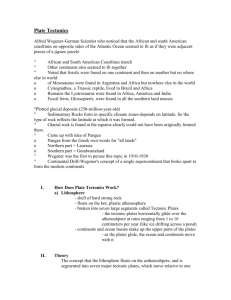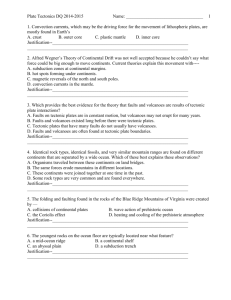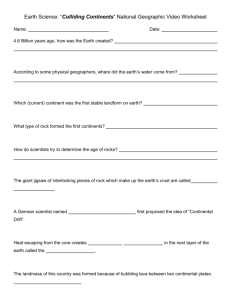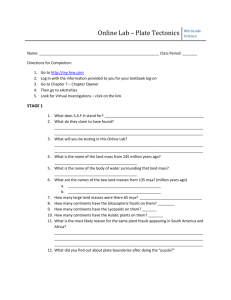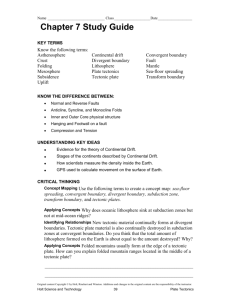Plate Tectonics Concept Review
advertisement
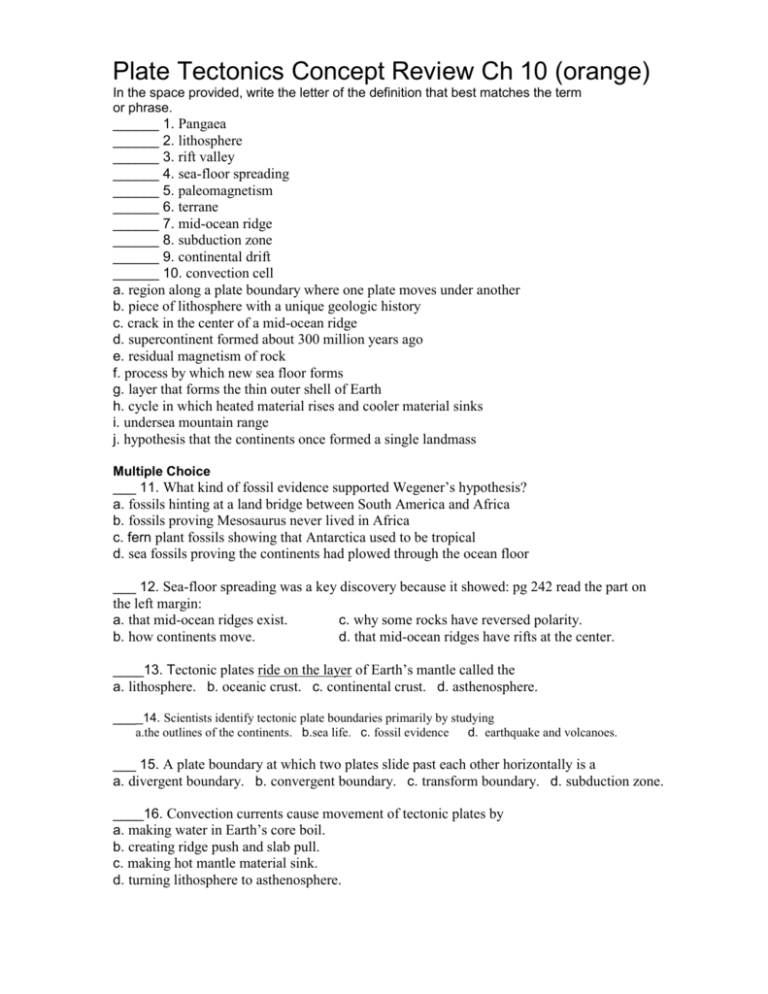
Plate Tectonics Concept Review Ch 10 (orange) In the space provided, write the letter of the definition that best matches the term or phrase. ______ 1. Pangaea ______ 2. lithosphere ______ 3. rift valley ______ 4. sea-floor spreading ______ 5. paleomagnetism ______ 6. terrane ______ 7. mid-ocean ridge ______ 8. subduction zone ______ 9. continental drift ______ 10. convection cell a. region along a plate boundary where one plate moves under another b. piece of lithosphere with a unique geologic history c. crack in the center of a mid-ocean ridge d. supercontinent formed about 300 million years ago e. residual magnetism of rock f. process by which new sea floor forms g. layer that forms the thin outer shell of Earth h. cycle in which heated material rises and cooler material sinks i. undersea mountain range j. hypothesis that the continents once formed a single landmass Multiple Choice ___ 11. What kind of fossil evidence supported Wegener’s hypothesis? a. fossils hinting at a land bridge between South America and Africa b. fossils proving Mesosaurus never lived in Africa c. fern plant fossils showing that Antarctica used to be tropical d. sea fossils proving the continents had plowed through the ocean floor ___ 12. Sea-floor spreading was a key discovery because it showed: pg 242 read the part on the left margin: a. that mid-ocean ridges exist. c. why some rocks have reversed polarity. b. how continents move. d. that mid-ocean ridges have rifts at the center. ____13. Tectonic plates ride on the layer of Earth’s mantle called the a. lithosphere. b. oceanic crust. c. continental crust. d. asthenosphere. ____14. Scientists identify tectonic plate boundaries primarily by studying a.the outlines of the continents. b.sea life. c. fossil evidence d. earthquake and volcanoes. ___ 15. A plate boundary at which two plates slide past each other horizontally is a a. divergent boundary. b. convergent boundary. c. transform boundary. d. subduction zone. ____16. Convection currents cause movement of tectonic plates by a. making water in Earth’s core boil. b. creating ridge push and slab pull. c. making hot mantle material sink. d. turning lithosphere to asthenosphere. ___ 17. New, smaller continents may form from larger continents through a. rifting. b. accretion. c. paleomagnetism. d. subduction. ___ 18. What often forms when large terranes and continents collide? a. mid-ocean ridges b. atolls c. seamounts d. major mountain chains ___ 19. The movements of the continents a. discourage the development of unique species. c. create fewer mountain ranges. b. keep climates constant. d. isolate some populations of organisms. ___ 20. One likely result of the supercontinent cycle is that a. the continents will continue to get further apart. b. California will move closer to the equator. c. the Mediterranean Sea will close. d. the Atlantic Ocean will disappear. Critical Thinking ANALOGIES In the space provided, write the letter of the pair of terms or phrases that best complete the analogy shown. An analogy is a relationship between two pairs of words or phrases written as a:b::c:d. The symbol : is read is to, and the symbol :: is read as. ____21.lithosphere : tectonic plates :: a. ceramic : dishes c. sky : stars b. slice : pie d. toy : batteries ____22.continents : tectonic plates :: a. ship : fish c. passengers : raft b. airplane : sky d. submarine : ocean ____23. earthquake : plate boundary :: a. avalanche : mountain c. snow : blizzard b. flood : desert d. cloud : puffy ____24. convection : mantle material :: a. cloud : rain c. temperature : heat b. boiling : water d. weigh : scale ____25. convergent : divergent :: a. hot : cold c. together : apart b. running : walking d. separating : meeting ____26. Panthalassa : Pangaea :: a. Lake Seminole : North America b. Atlantic : Virginia c. Asia : Europe d. Pacific Ocean : Hawaii Island
